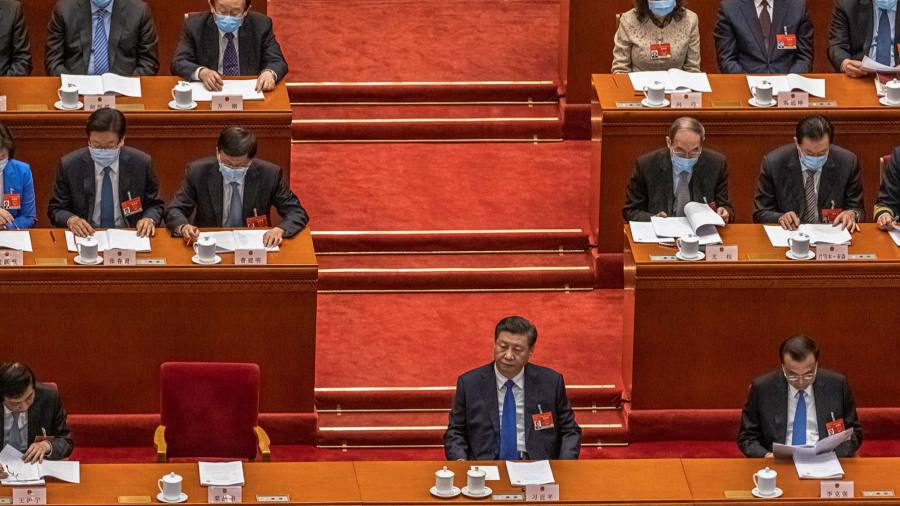[ad_1]
In the five months since Xi Jinping, China’s president, pledged that the country would reach net-zero carbon dioxide emissions by 2060, international observers have been waiting to see how the world’s largest greenhouse gas emitter intends to achieve that goal. They are still waiting.
China’s five-year economic blueprint published last week brought few strong measures to bear on Xi’s climate commitments. Instead, Beijing set targets similar or marginally higher than the previous five-year period. Analysts estimate these new goals allow for about 1 per cent of continued emissions growth through to 2025.
Environmentalists now fear that the lack of strict measures — such as a hard cap on carbon dioxide emissions or a moratorium on new coal power plant construction — will make it more difficult for China to achieve peak emissions by 2030 as planned before hitting “carbon neutrality†by 2060.
They are now looking hopefully towards the next opportunity for a hardening of policy when China releases its first-ever climate change five-year plan later this year.
“If we want to achieve carbon neutrality, it’s very necessary to pledge to decline early, otherwise you are aiming for a sharp decline later on when it is not necessarily possible,†said Hu Min, director of the Innovative Green Development Program, a Beijing-based non-profit group.Â
Hu noted that studies on how to curb China’s carbon emissions mostly agreed that it was both technically possible and economically advantageous for China to reach peak emissions by 2025. The costs of electricity from solar and wind have plummeted, while research shows that about 43 per cent of China’s coal power plants now run at a net loss.
Yet China remains hesitant to force a rapid transition towards renewables.
Emissions intensity, or the amount of CO2Â produced per unit of gross domestic product, were again set at 18 per cent by 2025, the same level as the last five-year period.
A goal for non-fossil fuels energy consumption was set at 20 per cent, up from a 15 per cent goal for 2020 — a relatively conservative target given China almost doubled its wind and solar power installations last year.
Among the more substantial changes from the previous 2016 plan was a pledge to “basically eliminate†bad air pollution days by 2025, and a decision to scrap a single GDP target for the five-year period, an indication that priorities are shifting away from growth above all else and towards environmental concerns.
Still, the country has so far struggled to shift substantially from a reliance on polluting industries, especially during economic downturns. Soaring steel, cement and aluminium production during China’s rapid recovery from coronavirus lockdowns meant that China was among only a handful of countries to increase carbon dioxide emissions in 2020, which jumped 4 per cent year on year in the second half.
At the same time as the installation of new wind and solar power plants have surged, local governments have approved construction of polluting coal power plants at a rapid pace. China last year built three times as much coal power capacity as the rest of the world combined and initiated 73 gigawatts of new projects, according to Global Energy Monitor, a non-profit organisation.
An important reason for a lack of immediate action was that China’s Ministry of Ecology and Environment, the body given the task of realising Xi’s climate ambitions, had yet to overcome pushback from provinces and industries convinced that coal and polluting industries were necessary to ensure energy security and economic growth, analysts said.
““There is a very active tug of war — some coal-dependent regions and sectors are less keen on rapidly reducing emissions,†said Dimitri de Boer, China head of ClientEarth, an environmental law charity. But there were some signs of the central government becoming more willing to call out laggards, he added.Â
Last month, the “central ecological and environmental inspection team,†a powerful body set up in 2015, released a strongly worded criticism of the National Energy Administration, accusing it of failing to manage coal power expansion or give environmental protection “the status it deservesâ€. The administration has yet to respond.
International climate negotiations may also accelerate China’s commitments. An updated pledge to reduce greenhouse gas emissions by the US expected in April could add urgency to China’s planning process, as the world’s two largest economies compete to be seen as leaders in global climate negotiations.
In December, Xi announced a handful of new targets to help hit China’s Paris accord commitments towards keeping global warming to well below 2C, including a goal of installing 1200GW of wind and solar power by 2030.
Even so, Climate Action Tracker, a non-profit research group, rates China’s policies as “highly insufficient,†a verdict they said was unchanged by the latest five-year plan.
Environmentalists hold out hope for stronger goals in sectoral plans and China’s climate change five-year plan set to be released later this year. Provincial plans to hit peak carbon emissions must be submitted to the central government before the end of the year.
Coordinating energy intensity and consumption targets across provinces will be an especially tough task for the environment ministry, with important questions about how to account for industrial disparities between provinces remaining unresolved, said Yan Qin, an Oslo-based analyst at Refinitiv, the financial data platform provider.
Rich provinces with consumer-oriented economies on China’s east coast, such as Shanghai and Jiangsu, have pledged to achieve peak emissions far earlier than Xi’s 2030 deadline, but that has sparked an unresolved debate about what emissions goals are justified for places such as Inner Mongolia that burn coal in order to help power other provinces. “The maths just doesn’t add up yet,†she said.
Additional reporting by Emma Zhou
Follow @ftclimate on Instagram
Climate Capital

Where climate change meets business, markets and politics. Explore the FT’s coverage hereÂ
[ad_2]
Source link





